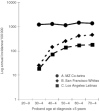Heritable breast cancer in twins
- PMID: 12177798
- PMCID: PMC2364223
- DOI: 10.1038/sj.bjc.6600429
Heritable breast cancer in twins
Abstract
Known major mutations such as BRCA1/2 and TP53 only cause a small proportion of heritable breast cancers. Co-dominant genes of lower penetrance that regulate hormones have been thought responsible for most others. Incident breast cancer cases in the identical (monozygotic) twins of representative cases reflect the entire range of pertinent alleles, whether acting singly or in combination. Having reported the rate in twins and other relatives of cases to be high and nearly constant over age, we now examine the descriptive and histological characteristics of the concordant and discordant breast cancers occurring in 2310 affected pairs of monozygotic and fraternal (dizygotic) twins in relation to conventional expectations and hypotheses. Like other first-degree relatives, dizygotic co-twins of breast cancer cases are at higher than usual risk (standardised incidence ratio (SIR)=1.7, CI=1.1-2.6), but the additional cases among monozygotic co-twins of cases are much more numerous, both before and after menopause (SIR=4.4, CI=3.6-5.6), than the 100% genetic identity would predict. Monozygotic co-twin diagnoses following early proband cancers also occur more rapidly than expected (within 5 years, SIR=20.0, CI=7.5-53.3). Cases in concordant pairs represent heritable disease and are significantly more likely to be oestrogen receptor-positive than those of comparable age from discordant pairs. The increase in risk to the monozygotic co-twins of cases cannot be attributed to the common environment, to factors that cumulate with age, or to any aggregate of single autosomal dominant mutations. The genotype more plausibly consists of multiple co-existing susceptibility alleles acting through heightened susceptibility to hormones and/or defective tumour suppression. The resultant class of disease accounts for a larger proportion of all breast cancers than previously thought, with a rather high overall penetrance. Some of the biological characteristics differ from those of breast cancer generally.
Copyright 2002 Cancer Research UK
Figures
References
-
- AisenbergAFinkelsteinDDoppkeKKoernerFBoivinJ-FCGW1997High risk of breast carcinoma after irradiation of young women with Hodgkin's disease Cancer 7912031210 - PubMed
-
- AndersenTHeimdalKSkredeMTveitKBergKBorresenA-L1994Oestrogen receptor (ESR) polymorphisms and breast cancer susceptibility Hum Genet 94665670 - PubMed
-
- AnsickSKononenJWalkerRAzorsaDMMTGuanX-YSauterGKallioniemiO-PTrentJMeltzerP1997AlB1, a steroid receptor coactivator amplified in breast and ovarian cancer Science 277965968 - PubMed
-
- ArmesJETruteLWhiteDSoutheyMCHammetFTesorieroAHutchinsAMDiteGSMcCredieMRGilesGGHopperJLVenterDJ1999Distinct molecular pathogeneses of early-onset breast cancers in BRCA1 and BRCA2 mutation carriers: a population-based study Cancer Res 5920112017 - PubMed
-
- BerkeyCGardnerJDFrazierAColditzG2000Relation of childhood diet and body size to menarche and adolescent growth in girls Am J Epidemiol 152446452 - PubMed
Publication types
MeSH terms
Grants and funding
LinkOut - more resources
Full Text Sources
Medical
Research Materials
Miscellaneous



